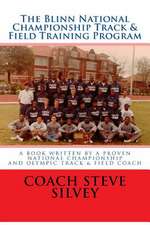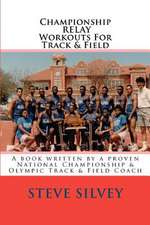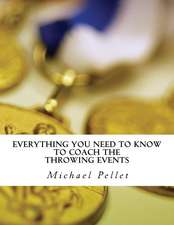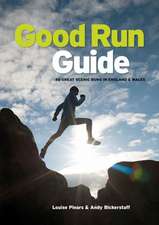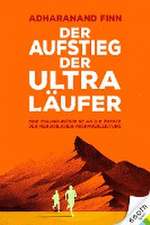Running with the Kenyans
Autor Adharanand Finnen Limba Engleză Paperback – 4 apr 2013
| Toate formatele și edițiile | Preț | Express |
|---|---|---|
| Paperback (2) | 82.06 lei 3-5 săpt. | +9.92 lei 6-12 zile |
| FABER & FABER – 4 apr 2013 | 82.06 lei 3-5 săpt. | +9.92 lei 6-12 zile |
| BALLANTINE BOOKS – 8 apr 2013 | 106.45 lei 3-5 săpt. |
Preț: 82.06 lei
Nou
Puncte Express: 123
Preț estimativ în valută:
15.70€ • 16.51$ • 12.97£
15.70€ • 16.51$ • 12.97£
Carte disponibilă
Livrare economică 27 martie-10 aprilie
Livrare express 12-18 martie pentru 19.91 lei
Preluare comenzi: 021 569.72.76
Specificații
ISBN-13: 9780571274062
ISBN-10: 0571274064
Pagini: 320
Dimensiuni: 125 x 198 x 22 mm
Greutate: 0.24 kg
Ediția:Main
Editura: FABER & FABER
ISBN-10: 0571274064
Pagini: 320
Dimensiuni: 125 x 198 x 22 mm
Greutate: 0.24 kg
Ediția:Main
Editura: FABER & FABER
Notă biografică
Adharanand Finn is a journalist at The Guardian and a freelance writer, contributing regular features for The Guardian, The Independent, and Runner’s World (U.K.).
Extras
One
Running in the Northamptonshire County Championships, 1988
We’re running across long, wavy grass, racing for the first corner. I’m right at the front, being pushed on by the charge of legs all around me, the quick breathing of my schoolmates. We run under the goalposts and swing down close beside the stone wall along the far edge of the field. It’s quieter now. I look around. One other boy is just behind me, but the others have all dropped back. Up ahead I can see the fluttering tape marking the next corner. I run on, the cold air in my lungs, the tall poplar trees shivering above my head.
We go out of the school grounds, along a gravel path that is normally out of bounds. My feet crunch along, the only sound. An old man pushing a bicycle stands to one side as I go by. I follow the tape, back down a steep slope on to the playing fields, back to the finish. I get there long before anyone else and stand waiting in the cold as the other runners come in, collapsing one after the other across the line. I watch them, rolling on their backs, kneeling on the ground, their faces red. I feel strangely elated. It’s the first PE class in my new school and we’ve all been sent out on a cross-country run. I’ve never tried running farther than the length of a football field before, so I’m surprised by how easy I find it.
“He’s not even breathing hard,” the teacher says, holding me up as an example to the others. He tells me to put my hands under my armpits to keep them warm as the other children continue to trail in.
N M
A few years later, at age twelve, I break the 800 meters school record on sports day, despite a few of the other boys attempting to bundle me over at the start in an effort to help their friend win. Five minutes later, I run the 1,500 meters and win that, too. When we get home, my dad, sensing some potential talent, suggests that I join the local running club and looks up the number in the telephone directory. I hear him talking to someone on the phone, asking directions. From that point on, a course is set: I am to be a runner.
It all begins rather inauspiciously one night a few weeks later. I put on my shorts and tracksuit and walk across the bridge to the shopping mall next to our suburban housing estate in Northampton, England, a town of 200,000 people sixty-five miles north of London. The precinct is half deserted, save for a few late shoppers coming out of the giant Tesco supermarket. I head down the escalator to the car park, and then across the road to the unmarked dirt track where the Northampton Phoenix running club meets. It’s a cold night and all the runners are crammed into a small doorway in the side of a huge redbrick wall. Inside, the corridor walls are painted bloodred and covered in lewd graffiti. Down the hall are the changing rooms, where men can be heard laughing loudly above the fizz of the showers. I give my name to a lady sitting at a small table.
Rather than head out onto the track, as I had imagined, I’m taken back across the road with a group of children my age, to the shopping mall’s delivery area, a stretch of covered road with shuttered loading bays all along one side. The road itself is thick with discharged oil. A man in tights and a yellow running jacket gets us to run from one side of the road to the other, touching the curb each time. Between each sprint he makes us do exercises such as push-ups or jumping jacks. I begin thinking, as I lie back on the cold, hard concrete ready to do some sit-ups, that I’ve come to the wrong place. This isn’t running. I had imagined groups of lithe athletes hurtling around a track. My dad must have gotten confused and called the wrong club.
N M
I’m so convinced this isn’t the running club that I don’t return for another year. When I do, they ask me if I’d like to train in “the tunnel”—which I take to mean the shopping mall loading bays—or head out for a long run. I opt for the long run and am directed over to a group of about forty people. This is more like it. As we set off along the gravel pathways that wind around the council estates of east Northampton, I feel for the first time the sensation of running in the middle of a group of people. The easy flow of our legs moving below us, the trees, houses, lakes floating by, the people stepping aside, letting us go. Although most of the other runners are older and constantly making jokes, as I drift quietly along, I feel a vague sense of belonging.
I spend the next six years or so as a committed member of the club, running track or cross-country races most weekends, and training at least twice a week. Much of my formative years I spend out pounding the roads. Even when I grow my hair long and start playing the guitar in a band, I keep on training. The other runners nickname me Bono. One night, when I’m about eighteen, I pass a bunch of my school friends coming back from the pub. We are going at full pace in the last mile of a long run. My school friends stare at me open mouthed as I charge by, one shouting, incredulously: “What are you doing?” as I disappear into the distance.
N M
I first become aware of Kenyan runners sometime in the mid-1980s, around the time I join the running club. They seem to emerge suddenly in large numbers into a running world dominated, in my eyes, by Britain’s Steve Cram and the Moroccan Said Aouita. I’m a big fan of both of these great rivals. Cram, with his high-stepping, majestic style; and the smaller Aouita, with his grimacing face and rocking shoulders, who is brilliant at every distance—from the short, fast 800 meters right up to the 10,000 meters.
But by the 1988 Olympics in Seoul, it is all Kenyans, winning every men’s middle-distance and long-distance track gold medal except one. What impresses me most about them is the way they run. The conventional wisdom is that the most efficient method, particularly in the longer distances, is to run at an even pace, and most races are run that way. The Kenyans, however, take a more maverick approach. They are always surging ahead, only to slow down suddenly, or sprinting off at a crazy pace right from the start. I love the way it befuddles the TV commentators, who are constantly predicting that a Kenyan athlete is going too fast, only to then see him go suddenly even faster.
I remember watching the 1993 world championship 5,000 meters final on a warm mid-August evening in our living room in Northampton. My mum keeps coming in and out, suggesting I go and sit outside in the garden. It’s a lovely evening, but I’m glued to the TV. The television cameras are focused on the prerace favorite, the Olympic champion from Morocco, Khalid Skah, and also on a young Ethiopian named Haile Gebrselassie, who won both the 5,000 meters and the 10,000 meters at the world junior championships the year before. The athletes stand side by side at the start line, looking back into the camera. They smile nervously when their names are announced, and give the odd directionless wave.
The race sets off at a blistering pace, with a succession of African athletes streaking ahead one after the other at the front. Skah, who has taken on and beaten the Kenyans many times before, tracks their every move, always sitting on the shoulder of the leader. Britain’s only runner in the race, Rob Denmark, soon finds himself trailing far behind.
With seven laps still to go, the BBC television commentator Brendan Foster is feeling the strain just watching. “It’s a vicious race out there,” he says. Right on queue, a young Kenyan, Ismael Kirui, surges to the front and, within a lap, opens up a huge gap of more than 150 feet on everyone else. It’s a suicidal move, Foster declares. “He’s only eighteen and has no real international experience. I think he’s got a little carried away.” I sit riveted, screaming at the TV as the coverage cuts away to the javelin for a few moments. When it switches back, Kirui is still leading. Lap after lap, Skah and a group of three Ethiopians track him, but they aren’t getting any closer. The camera zooms in on Kirui’s eyes, staring ahead, wild like a hunted animal as he keeps piling on the pace. “This is one savage race,” says Foster.
Kirui is still clear as the bell sounds for the last lap. Down the back straight he sprints for his life, but the three Ethiopians are flying now, closing the gap. With just over 100 meters left, Kirui glances over his shoulder and sees the figure of Gebrselassie closing in on him. For a brief second everything seems to stop. This is the moment, the kill is about to happen. Startled, frantic, Kirui turns back toward the front and urges his exhausted body on again, his tired legs somehow sprinting away down the finishing straight. He crosses the line less than half a second ahead of Gebrselassie, but he has done it. He has won. Battered and bewildered, he sets off on his lap of honor, the Kenyan flag, once again, held aloft in triumph.
That evening I head down to the track for a training session with my running club. I try to run like Kirui, staring straight ahead, going as fast as I can right from the start. It’s one of the best training sessions I ever have. Usually, if you run too hard at the beginning, you worry about how you’ll feel later. You can feel it in your body, the anticipation of the pain to come. Usually it makes you slow down. It’s called pacing yourself. But that night I don’t care. I want to unshackle myself and run free like a Kenyan.
N M
The night I spend hurtling wide-eyed around the track after watching Ismael Kirui turns out to be one of the last sessions I ever have with my running club. Just over a month later I pack my belongings into my parents’ car and drive up to Liverpool to begin college. Although I join the college running team, my focus on training is soon lost amid the whirlwind of university life. Like most teenage students, I’m unleashed into a new world in which anything seems possible. Running seems to belong in a previous life, although I never completely let go of it.
The extent to which my training peters out becomes clear by the time the British University cross-country championships come around the following March. The night before the race, I take off on a spontaneous road trip to Wales with three friends, clambering onto the team bus the next morning ready for little else other than sleep. It’s a miracle I make it at all.
A hundred miles away, in the small northern town of Durham, it’s a cold, blustery day. I lace up my spikes and go through the familiar routine of jogging and stretching, but once the race starts, my legs, sucked down by the thick mud, give up without a fight. I jog around, unable to rouse myself to run any faster. I finish in 280th position. My good friend and rival from my running days in Northampton, Ciaran Maguire, comes second. Just a few years earlier we battled neck and neck all the way in the county cross-country championships, until he edged past me on the line to win. And now here we are separated by almost three hundred people. I see him after the race. “All you need is to give yourself one good year of training,” he says consolingly. I nod, but deep down I know it is not going to happen.
Over the years, I’ve met others like me: former runners who still, every now and then, dig out their old sneakers and start lapping the local park in the vague hope of remembering what it felt like. We sign up to a local 10K or half marathon, determined to get back in shape. But something—life, an injury, a lack of dedication—always gets in the way, and we stop training. But the embers refuse to die, and we refuse to chuck our moldy old sneakers away. We know we might need them again, that the urge to run will return.
After I have children, it becomes even harder to find the time to train, that is, until I manage to land a freelance job writing race reports for Runner’s World magazine. Although it doesn’t pay much, it makes the running feel less self-indulgent. It isn’t just me doing something for myself in an effort to revive some lost childhood fervor. It is now work.
With regular assignments from Runner’s World, I start training more frequently over the next few years, although with young children it’s still hard to get out more than twice a week. I descend the stairs from my office to find Marietta with little Ossian hanging off her hip, struggling to get lunch ready, as my two daughters Lila and Uma are screeching at each other and tussling over a book. The yard is overgrown, the trash needs to be taken out, and the phone is ringing. It’s not easy to say, I’m just popping out for a long run. See you in an hour or so. So even though I start racing regularly, my times barely improve. I run my first half marathon when I’m twenty-nine, in 1 hour 30 minutes. Seven years later I’ve run three more in exactly the same time.
I keep telling myself that one day I will train hard and run really fast. I’m not sure what that would mean exactly—an under-three-hour marathon, perhaps? But the years are slipping away. Every time an athlete over thirty-five wins a big race on television, I tell myself that there is still hope. It isn’t that I want to achieve any specific goal; I just don’t want to look back one day and regret that I never gave myself a decent chance to see what I could do.
Running in the Northamptonshire County Championships, 1988
We’re running across long, wavy grass, racing for the first corner. I’m right at the front, being pushed on by the charge of legs all around me, the quick breathing of my schoolmates. We run under the goalposts and swing down close beside the stone wall along the far edge of the field. It’s quieter now. I look around. One other boy is just behind me, but the others have all dropped back. Up ahead I can see the fluttering tape marking the next corner. I run on, the cold air in my lungs, the tall poplar trees shivering above my head.
We go out of the school grounds, along a gravel path that is normally out of bounds. My feet crunch along, the only sound. An old man pushing a bicycle stands to one side as I go by. I follow the tape, back down a steep slope on to the playing fields, back to the finish. I get there long before anyone else and stand waiting in the cold as the other runners come in, collapsing one after the other across the line. I watch them, rolling on their backs, kneeling on the ground, their faces red. I feel strangely elated. It’s the first PE class in my new school and we’ve all been sent out on a cross-country run. I’ve never tried running farther than the length of a football field before, so I’m surprised by how easy I find it.
“He’s not even breathing hard,” the teacher says, holding me up as an example to the others. He tells me to put my hands under my armpits to keep them warm as the other children continue to trail in.
N M
A few years later, at age twelve, I break the 800 meters school record on sports day, despite a few of the other boys attempting to bundle me over at the start in an effort to help their friend win. Five minutes later, I run the 1,500 meters and win that, too. When we get home, my dad, sensing some potential talent, suggests that I join the local running club and looks up the number in the telephone directory. I hear him talking to someone on the phone, asking directions. From that point on, a course is set: I am to be a runner.
It all begins rather inauspiciously one night a few weeks later. I put on my shorts and tracksuit and walk across the bridge to the shopping mall next to our suburban housing estate in Northampton, England, a town of 200,000 people sixty-five miles north of London. The precinct is half deserted, save for a few late shoppers coming out of the giant Tesco supermarket. I head down the escalator to the car park, and then across the road to the unmarked dirt track where the Northampton Phoenix running club meets. It’s a cold night and all the runners are crammed into a small doorway in the side of a huge redbrick wall. Inside, the corridor walls are painted bloodred and covered in lewd graffiti. Down the hall are the changing rooms, where men can be heard laughing loudly above the fizz of the showers. I give my name to a lady sitting at a small table.
Rather than head out onto the track, as I had imagined, I’m taken back across the road with a group of children my age, to the shopping mall’s delivery area, a stretch of covered road with shuttered loading bays all along one side. The road itself is thick with discharged oil. A man in tights and a yellow running jacket gets us to run from one side of the road to the other, touching the curb each time. Between each sprint he makes us do exercises such as push-ups or jumping jacks. I begin thinking, as I lie back on the cold, hard concrete ready to do some sit-ups, that I’ve come to the wrong place. This isn’t running. I had imagined groups of lithe athletes hurtling around a track. My dad must have gotten confused and called the wrong club.
N M
I’m so convinced this isn’t the running club that I don’t return for another year. When I do, they ask me if I’d like to train in “the tunnel”—which I take to mean the shopping mall loading bays—or head out for a long run. I opt for the long run and am directed over to a group of about forty people. This is more like it. As we set off along the gravel pathways that wind around the council estates of east Northampton, I feel for the first time the sensation of running in the middle of a group of people. The easy flow of our legs moving below us, the trees, houses, lakes floating by, the people stepping aside, letting us go. Although most of the other runners are older and constantly making jokes, as I drift quietly along, I feel a vague sense of belonging.
I spend the next six years or so as a committed member of the club, running track or cross-country races most weekends, and training at least twice a week. Much of my formative years I spend out pounding the roads. Even when I grow my hair long and start playing the guitar in a band, I keep on training. The other runners nickname me Bono. One night, when I’m about eighteen, I pass a bunch of my school friends coming back from the pub. We are going at full pace in the last mile of a long run. My school friends stare at me open mouthed as I charge by, one shouting, incredulously: “What are you doing?” as I disappear into the distance.
N M
I first become aware of Kenyan runners sometime in the mid-1980s, around the time I join the running club. They seem to emerge suddenly in large numbers into a running world dominated, in my eyes, by Britain’s Steve Cram and the Moroccan Said Aouita. I’m a big fan of both of these great rivals. Cram, with his high-stepping, majestic style; and the smaller Aouita, with his grimacing face and rocking shoulders, who is brilliant at every distance—from the short, fast 800 meters right up to the 10,000 meters.
But by the 1988 Olympics in Seoul, it is all Kenyans, winning every men’s middle-distance and long-distance track gold medal except one. What impresses me most about them is the way they run. The conventional wisdom is that the most efficient method, particularly in the longer distances, is to run at an even pace, and most races are run that way. The Kenyans, however, take a more maverick approach. They are always surging ahead, only to slow down suddenly, or sprinting off at a crazy pace right from the start. I love the way it befuddles the TV commentators, who are constantly predicting that a Kenyan athlete is going too fast, only to then see him go suddenly even faster.
I remember watching the 1993 world championship 5,000 meters final on a warm mid-August evening in our living room in Northampton. My mum keeps coming in and out, suggesting I go and sit outside in the garden. It’s a lovely evening, but I’m glued to the TV. The television cameras are focused on the prerace favorite, the Olympic champion from Morocco, Khalid Skah, and also on a young Ethiopian named Haile Gebrselassie, who won both the 5,000 meters and the 10,000 meters at the world junior championships the year before. The athletes stand side by side at the start line, looking back into the camera. They smile nervously when their names are announced, and give the odd directionless wave.
The race sets off at a blistering pace, with a succession of African athletes streaking ahead one after the other at the front. Skah, who has taken on and beaten the Kenyans many times before, tracks their every move, always sitting on the shoulder of the leader. Britain’s only runner in the race, Rob Denmark, soon finds himself trailing far behind.
With seven laps still to go, the BBC television commentator Brendan Foster is feeling the strain just watching. “It’s a vicious race out there,” he says. Right on queue, a young Kenyan, Ismael Kirui, surges to the front and, within a lap, opens up a huge gap of more than 150 feet on everyone else. It’s a suicidal move, Foster declares. “He’s only eighteen and has no real international experience. I think he’s got a little carried away.” I sit riveted, screaming at the TV as the coverage cuts away to the javelin for a few moments. When it switches back, Kirui is still leading. Lap after lap, Skah and a group of three Ethiopians track him, but they aren’t getting any closer. The camera zooms in on Kirui’s eyes, staring ahead, wild like a hunted animal as he keeps piling on the pace. “This is one savage race,” says Foster.
Kirui is still clear as the bell sounds for the last lap. Down the back straight he sprints for his life, but the three Ethiopians are flying now, closing the gap. With just over 100 meters left, Kirui glances over his shoulder and sees the figure of Gebrselassie closing in on him. For a brief second everything seems to stop. This is the moment, the kill is about to happen. Startled, frantic, Kirui turns back toward the front and urges his exhausted body on again, his tired legs somehow sprinting away down the finishing straight. He crosses the line less than half a second ahead of Gebrselassie, but he has done it. He has won. Battered and bewildered, he sets off on his lap of honor, the Kenyan flag, once again, held aloft in triumph.
That evening I head down to the track for a training session with my running club. I try to run like Kirui, staring straight ahead, going as fast as I can right from the start. It’s one of the best training sessions I ever have. Usually, if you run too hard at the beginning, you worry about how you’ll feel later. You can feel it in your body, the anticipation of the pain to come. Usually it makes you slow down. It’s called pacing yourself. But that night I don’t care. I want to unshackle myself and run free like a Kenyan.
N M
The night I spend hurtling wide-eyed around the track after watching Ismael Kirui turns out to be one of the last sessions I ever have with my running club. Just over a month later I pack my belongings into my parents’ car and drive up to Liverpool to begin college. Although I join the college running team, my focus on training is soon lost amid the whirlwind of university life. Like most teenage students, I’m unleashed into a new world in which anything seems possible. Running seems to belong in a previous life, although I never completely let go of it.
The extent to which my training peters out becomes clear by the time the British University cross-country championships come around the following March. The night before the race, I take off on a spontaneous road trip to Wales with three friends, clambering onto the team bus the next morning ready for little else other than sleep. It’s a miracle I make it at all.
A hundred miles away, in the small northern town of Durham, it’s a cold, blustery day. I lace up my spikes and go through the familiar routine of jogging and stretching, but once the race starts, my legs, sucked down by the thick mud, give up without a fight. I jog around, unable to rouse myself to run any faster. I finish in 280th position. My good friend and rival from my running days in Northampton, Ciaran Maguire, comes second. Just a few years earlier we battled neck and neck all the way in the county cross-country championships, until he edged past me on the line to win. And now here we are separated by almost three hundred people. I see him after the race. “All you need is to give yourself one good year of training,” he says consolingly. I nod, but deep down I know it is not going to happen.
Over the years, I’ve met others like me: former runners who still, every now and then, dig out their old sneakers and start lapping the local park in the vague hope of remembering what it felt like. We sign up to a local 10K or half marathon, determined to get back in shape. But something—life, an injury, a lack of dedication—always gets in the way, and we stop training. But the embers refuse to die, and we refuse to chuck our moldy old sneakers away. We know we might need them again, that the urge to run will return.
After I have children, it becomes even harder to find the time to train, that is, until I manage to land a freelance job writing race reports for Runner’s World magazine. Although it doesn’t pay much, it makes the running feel less self-indulgent. It isn’t just me doing something for myself in an effort to revive some lost childhood fervor. It is now work.
With regular assignments from Runner’s World, I start training more frequently over the next few years, although with young children it’s still hard to get out more than twice a week. I descend the stairs from my office to find Marietta with little Ossian hanging off her hip, struggling to get lunch ready, as my two daughters Lila and Uma are screeching at each other and tussling over a book. The yard is overgrown, the trash needs to be taken out, and the phone is ringing. It’s not easy to say, I’m just popping out for a long run. See you in an hour or so. So even though I start racing regularly, my times barely improve. I run my first half marathon when I’m twenty-nine, in 1 hour 30 minutes. Seven years later I’ve run three more in exactly the same time.
I keep telling myself that one day I will train hard and run really fast. I’m not sure what that would mean exactly—an under-three-hour marathon, perhaps? But the years are slipping away. Every time an athlete over thirty-five wins a big race on television, I tell myself that there is still hope. It isn’t that I want to achieve any specific goal; I just don’t want to look back one day and regret that I never gave myself a decent chance to see what I could do.
Recenzii
Advance praise for Running with the Kenyans
“Completely satisfying, as well-paced and exhilarating as a good run.”—The Boston Globe
“Not everyone gets to heaven in their lifetime. Adharanand Finn tried to run there, and succeeded. Running with the Kenyans is a great read.”—Bernd Heinrich, author of Why We Run
“Part scientific study, travel memoir, and tale of self-discovery, Finn’s journey makes for a smart and entertaining read.”—Publishers Weekly
“A hymn to the spirit, to the heartbreaking beauty of tenacity, to the joy of movement.”—The Plain Dealer
“Equal parts cultural examination, cult-of-running treatise, and poignant memoir, Running with the Kenyans thrives on a variety of levels. Like the skilled distance runner he is, Finn paces this book marvelously and then saves the best for the final kick. This book packs all the pleasure and satisfaction—and none of the ancillary pain—of a long training run.”—L. Jon Wertheim, senior editor, Sports Illustrated, and co-author of the New York Times bestseller Scorecasting
“Not everyone gets to heaven in their lifetime. Finn tried to run there, and succeeded. Running with the Kenyans is a great read.”—Bernd Heinrich, author of Why We Run
“If you want to know the secrets of Kenyan runners, and have a rollicking adventure along the way, join Finn in his fascinating tale of what it is to go stride for stride with the fastest people on Earth.”—Neal Bascomb, author of The Perfect Mile
“An extremely good book . . . If Born to Run taught us what to wear (or not to wear) when running, Finn’s fascinating Running with the Kenyans teaches us how to run. . . . In the tradition of the best sports writing, Finn embedded himself fully in his subject and reveals, for the first time, just how close we are to the holy grail of the sub-two-hour marathon.”—Robin Harvie, author of The Lure of Long Distances
“A beautiful and inspiring must-have for every runner, Running with the Kenyans is far more than an inspirational story, but a guide toward running, humility, and life, from the amazing people of Kenya.”—Michael Sandler, author of Barefoot Running
“Completely satisfying, as well-paced and exhilarating as a good run.”—The Boston Globe
“Not everyone gets to heaven in their lifetime. Adharanand Finn tried to run there, and succeeded. Running with the Kenyans is a great read.”—Bernd Heinrich, author of Why We Run
“Part scientific study, travel memoir, and tale of self-discovery, Finn’s journey makes for a smart and entertaining read.”—Publishers Weekly
“A hymn to the spirit, to the heartbreaking beauty of tenacity, to the joy of movement.”—The Plain Dealer
“Equal parts cultural examination, cult-of-running treatise, and poignant memoir, Running with the Kenyans thrives on a variety of levels. Like the skilled distance runner he is, Finn paces this book marvelously and then saves the best for the final kick. This book packs all the pleasure and satisfaction—and none of the ancillary pain—of a long training run.”—L. Jon Wertheim, senior editor, Sports Illustrated, and co-author of the New York Times bestseller Scorecasting
“Not everyone gets to heaven in their lifetime. Finn tried to run there, and succeeded. Running with the Kenyans is a great read.”—Bernd Heinrich, author of Why We Run
“If you want to know the secrets of Kenyan runners, and have a rollicking adventure along the way, join Finn in his fascinating tale of what it is to go stride for stride with the fastest people on Earth.”—Neal Bascomb, author of The Perfect Mile
“An extremely good book . . . If Born to Run taught us what to wear (or not to wear) when running, Finn’s fascinating Running with the Kenyans teaches us how to run. . . . In the tradition of the best sports writing, Finn embedded himself fully in his subject and reveals, for the first time, just how close we are to the holy grail of the sub-two-hour marathon.”—Robin Harvie, author of The Lure of Long Distances
“A beautiful and inspiring must-have for every runner, Running with the Kenyans is far more than an inspirational story, but a guide toward running, humility, and life, from the amazing people of Kenya.”—Michael Sandler, author of Barefoot Running





